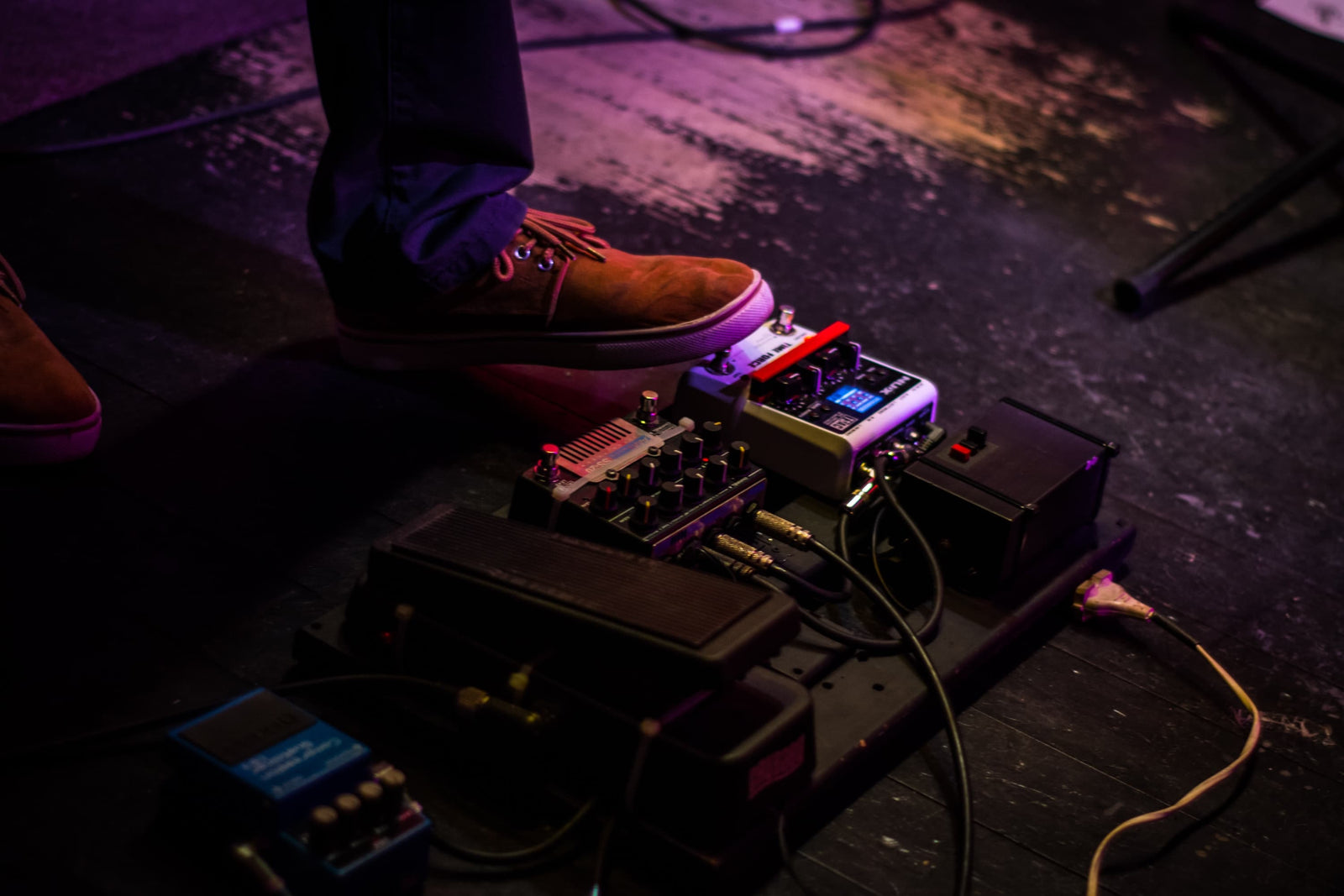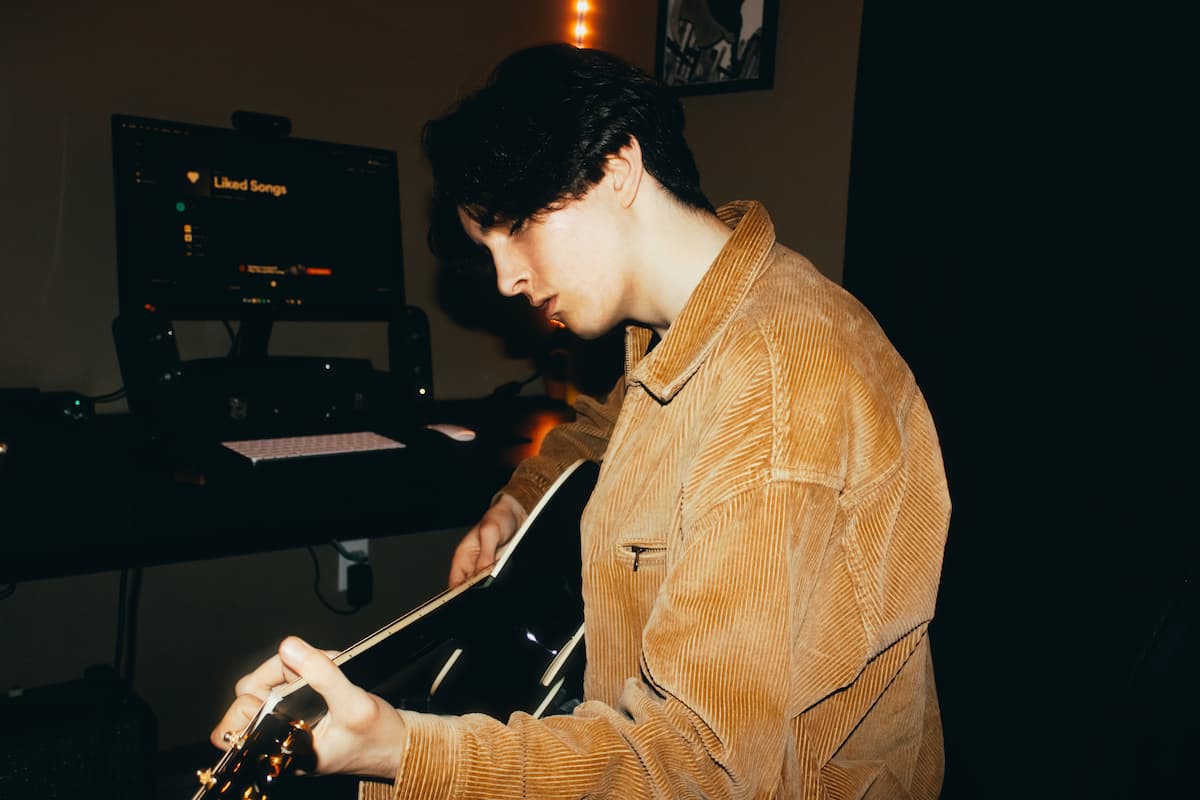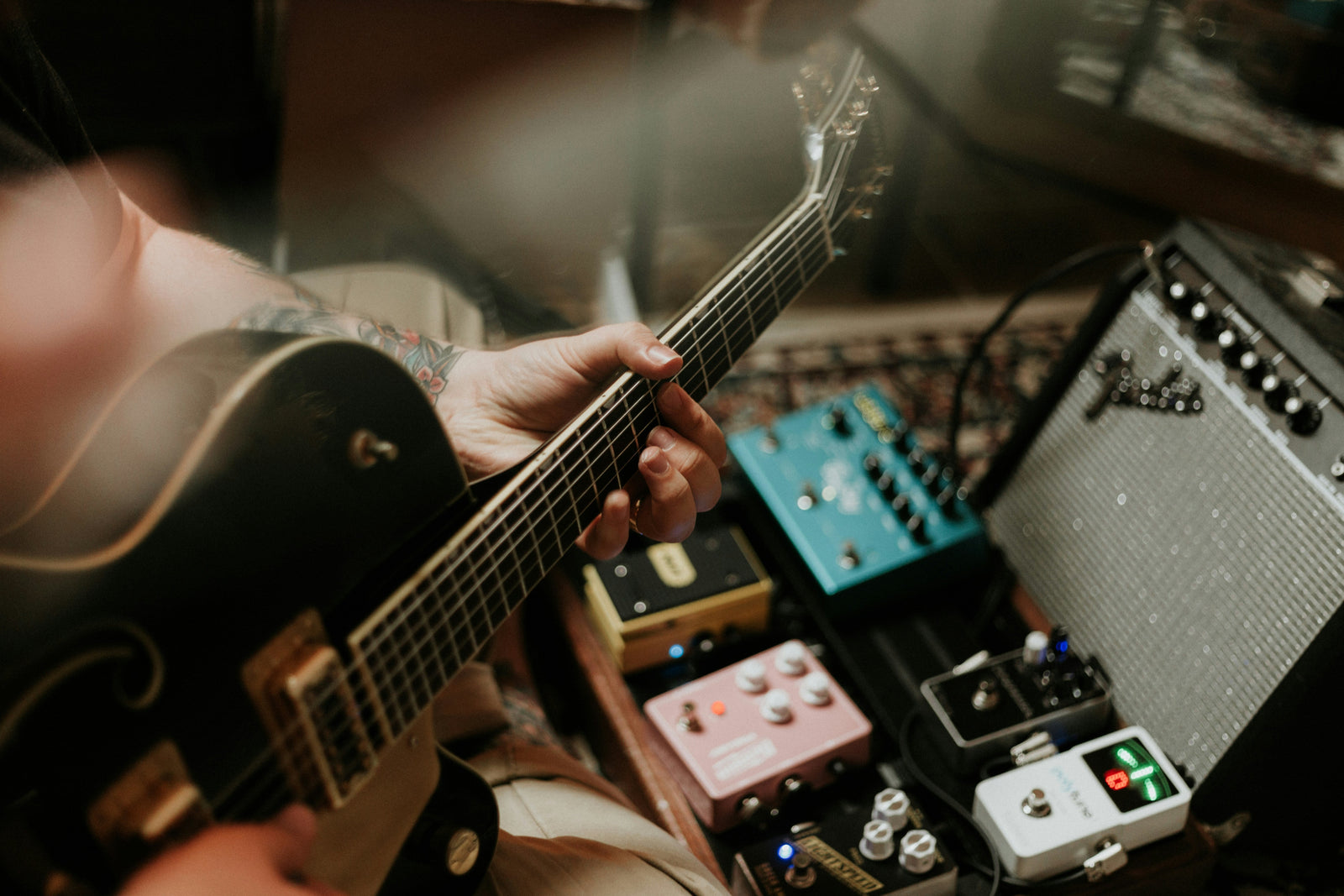BOSS Guitar Pedals: Distortion/Overdrive/Fuzz
Welcome to our journey into BOSS Guitar Pedals, exploring distortion, overdrive, and fuzz. If you desire subtle harmonics, overdrive is for you. Seeking crunch and sustain? Distortion is the sound in your mind. Ready to transform your sound? Fuzz takes you there.
Navigating overdrive, distortion, and fuzz may seem perplexing. But, distinctions are clear – each clips the signal in different ways. Your choice depends on your style and sonic vision.
Whether reshaping your amp or infusing flavors into your rig. Rest assured that these pedals will serve many purposes. From signal boosters to treble enhancers, they amplify versatility. This allows opening gates to sonic exploration.
Join us as we delve into BOSS guitar pedals distortion, overdrive, and fuzz. Experience a gateway to unmatched sonic possibilities.
What is a BOSS Guitar Pedal Distortion?
A BOSS guitar pedal distortion is a key component in a guitarist's gear. It facilitates easy switching between effects during live performances. Distortion pedals reflect a musician's style and genre. A suitable distortion pedal aligns with your unique musical identity. These pedals are essential across genres like rock, metal, and blues.
Distortion pedals transform your guitar's sound. They offer a spectrum from light overdrive to heavy metal tones. This versatility moves your sound from mellow to intense. Distortion pedals encourage experimentation beyond conventional playing.
They are crucial for live performances of your practiced tunes. Guitar pedals can create distinctive sound combinations. The variety in distortion pedals ranges from subtle to dramatic effects. BOSS guitar pedal distortion provides a balance of control and intensity. They allow guitarists to shape their sound with precision.
Each BOSS guitar pedal distortion offers a unique sound signature. These pedals are durable and reliable for any playing condition. BOSS guitar pedals earn renown for their quality and sound versatility. They are an investment in your musical expression and performance. Explore the range to find the BOSS guitar pedal distortion that resonates with your style.
Types of BOSS Guitar Pedal Distortion
Distortion pedals, each with unique traits, are crucial in shaping guitar tones. The main types include overdrive, distortion, and fuzz.
Navigating the variety of guitar distortion pedals can be challenging. Our guide below details different types of distortion pedals. Learn how these effects enhance your guitar tone.
BOSS Guitar Pedal Overdrive
BOSS guitar pedals overdrive encapsulates rock and roll's essence. Ideal for genres from blues to heavy rock, they're essential for guitarists. Often, an overdrive pedal is a primary addition to a pedalboard.
Overdrive is a celebrated guitar effect, enhancing tube-like tones and sustain. BOSS guitar pedals overdrive deliver a warm, full sound, versatile across music styles. These pedals are great for those seeking extra gain, tone, and sustain. They're especially suitable for rock, blues, and country guitar.
Guitar enthusiasts often favor the overdrive pedal for its smooth distortion. Using solid-state electronics, they offer controlled, smooth tones. Overdrive pedals are key in achieving the beloved guitar tones. There are many variations of this effect, each with unique applications.
Overdrive pedals replicate the tones produced by a tube amp pushed to its limits. This results in a distinctive, sustained distortion. They produce the effect of a tube amp pushed to its limits. The sound, especially at lower gains, resembles an overdriven amp.
To appreciate the capabilities of overdrive pedals, let's listen to Johnny DeMarco. Their usage demonstrates the pedal's versatility and impact. Understanding overdrive pedals is crucial for any guitarist. These pedals transform simple riffs into powerful musical statements. Explore BOSS guitar pedals overdrive to find your perfect tone.
BOSS Guitar Pedals: Overdrive
- JB-2 Angry Driver
- BD-2W Blues Driver
- SD-1W Super OverDrive
- OD-1X OverDrive
- BD-2 Blues Driver
- OD-3 OverDrive
- SD-1 Super OverDrive
TOP BOSS Guitar Pedal Overdrive: BD-2 Blues Driver
The BD-2 Blues Driver is a quintessential pedal for rock and blues. It's versatile, delivering everything from smooth overdrive to full distortion. Built tough, like all-tube amplifiers, ensuring durability. This pedal offers ample clean headroom for optimal tube amp performance.
Regarded as a standard in blues, the BD-2 excels in emotional response. Its range includes subtle crunch and intense overdrive. With adjustable controls, it caters to various styles and tones. The BD-2 stands out as a versatile overdrive pedal. It produces natural, amp-like overdriven tones, enhancing solos and lead parts.
Designed for simplicity, it incorporates intuitive switches and knobs. Ideal for both beginners and experienced players. The BD-2 offers a spectrum of tones from blues warmth to rock crunch.
- Versatile overdrive for diverse musical genres.
- Rugged construction for lasting performance.
- Natural amp-like tones for an authentic sound.
- Intuitive interface, ideal for beginners.
- Wide tonal range, from warm blues to rock crunch.
BOSS Guitar Pedal Fuzz
Fuzz pedals, integral to distortion effects, have a long history. They simulated overdriven sounds for guitars plugged into radios. Fuzz pedals vary from classic designs to those with modern features.
Fuzz is a distinct type of distortion, prominent in early rock n' roll. It produces a fuzzy, dirty sound, often with fewer high frequencies. This raw sound differs from the smoother tones of distortion or overdrive. Despite their simple design, fuzz pedals create a heavy, vintage distortion.
Most fuzz pedals use either germanium or silicon mechanisms. Germanium-based pedals yield a subtle, warm distortion. Silicon-based pedals provide more intense distortion but less warmth.
Fuzz pedals offer a unique, powerful tone that's memorable. Their simplicity makes them ideal for beginners or as an affordable option. BOSS Fuzz effects are perfect for classic rock sounds without sacrificing quality.
Explore the range of BOSS guitar pedals fuzz for that iconic rock sound. They're great for those seeking a raw, vintage tone. Whether for guitar or bass, BOSS guitar pedals fuzz enhance your music. Their design appeals to players at all levels, making it easy to use. Dive into the world of fuzz with BOSS for a memorable musical experience.
Let's listen to the sound of a Fuzz effect pedal by watching this video from BOSS Channel:
BOSS Guitar Pedals: Fuzz
TOP BOSS Guitar Pedal Fuzz: FZ-5 Fuzz
The FZ-5 is a modern pedal designed for today's guitarist, offering retro fuzz tones. It harnesses BOSS's advanced COSM technology to recreate vintage fuzz sounds. This pedal channels the essence of '60s and '70s rock. The FZ-5 allows you to relive the sounds of legendary pedals like the Maestro FZ-1A. Its Boost knob intensifies the effect for more aggressive tones.
The FZ-5 is a favorite among guitarists for its classic fuzz effects. It delivers an all-out fuzz that transforms guitar sounds. Its unique sound sets it apart from other pedals. The FZ-5 produces a dominant and chaotic sound. It's perfect for those seeking extreme distortion.
BOSS FZ-5 stands out as a top fuzz pedal for electric guitars. It offers a wide range of tones, making it versatile. The pedal is durable and produces minimal noise. It provides full, thick fuzz levels and has three distinct modes.
- Retro fuzz tones with modern reliability.
- Boost knob for intensified fuzz effects.
- Three modes for versatile sound options.
BOSS Guitar Pedal Distortion
Distortion in guitar pedals is a key effect, particularly prominent in metal music. It encompasses a range of sounds, often harsher than fuzz boxes. Distortion pedals are versatile, fitting across various music genres.
These pedals overdrive the sound. Amplifying the signal's waveform for a grainy, intense tone. Distortion pedals originated to mimic live rock concert sounds from the 1960s. They produce a distinct "metal" sound, different from other effects. These pedals are not only for solos but also for adding character to rhythm sections.
BOSS guitar pedal distortion excels in delivering heavy metal tones with ease. With a wide variety to choose from, finding the right one is crucial. All BOSS guitar pedals include a distortion effect, a staple in the effects world. Distortion is often perceived as harsher than overdrive, with more distinct note clarity. To some, it resembles fuzz, highlighting its diverse interpretations.
Understanding the nuances of BOSS guitar pedal distortion can enhance your playing. Each BOSS guitar pedal offers unique characteristics to explore and master. Experimentation with these pedals can unlock new dimensions in your guitar sound. Whether for solos or rhythm, BOSS guitar pedal distortion adds depth and intensity to your music.
Take a look as John Dreyer shows you how to achieve clean and distorted tones in your playing!
BOSS Guitar Pedals: Distortion
- DS-1W Distortion
- HM-2W Heavy Metal
- MT-2W Metal Zone
- DS-1X Distortion
- DS-1 Distortion
- DS-2 Turbo Distortion
- MD-2 Mega Distortion
- ML-2 Metal Core
- MT-2 Metal Zone
- ST-2 Power Stack
TOP BOSS Guitar Pedal Distortion: ML-2 Metal Core
The ML-2 is BOSS's most potent and heavy distortion pedal. It excels in delivering extreme gain for genres like Nu Metal and Grind Core. The pedal's heavy lows and massive distortion suit various aggressive styles.
The ML-2 stands out with its biting tone and ability to cut through intense rhythms. Following the DS-1 and DS-2, it brings an even tighter tone and greater distortion. It's low-end and mids pack a gut-punching gain, ideal for metal enthusiasts.
Designed for metal gods, the ML-2 pushes distortion to the edge. It's perfect for playing extreme metal with its thick, grinding lows. Despite its lean towards metal, it's versatile enough for other genres. The ML-2 is especially suited for nu-metal, industrial, and similar high-gain styles.
- Extreme gain for high-intensity music genres.
- Tight tone with gut-punching mids and heavy lows.
- Versatile for metal, nu-metal, and industrial styles.
Explore the ML-2 for a distortion experience that's both ferocious and nuanced. This pedal is a testament to BOSS's excellence in creating powerful effects. Whether for studio recordings or live performances, the ML-2 is a game-changer. Experience the full force of metal with the BOSS ML-2 Metal Core Pedal.
What’s the Difference between BOSS Guitar Pedals Distortion and Overdrive?
In the intricate world of BOSS guitar pedals, confusion is a common occurrence. Often, we need to clarify the distinctions between overdrive and distortion. This confusion leads to misunderstandings among musicians.
This guide aims to shed light on these two essential sound effects.
Decoding Overdrive: A Subtle Dance with Tube Amps
Unlock the warmth of classic rock with overdrive. A sonic journey that mimics the cranked tube amp. BOSS OD-1 and SD-1 pedals bring this magic to your fingertips. It ensures a touch-sensitive, organic tone that resonates with every strum.
Embracing the simplicity of overdrive:
- Natural Grit: Feel the vigor of a tube amp without losing your original sound.
- Preserving Your Sound:Overdrive pedals emulate the natural grit of a tube amp. Ensuring your original sound shines through. Adjust volume and attack, and watch your guitar come alive.
Mastering Distortion: From Rebellion to Sonic Brilliance
Distortion is the rebel in the pedal family, creating a wild, intense sound. Picture the opening riff of "Revolution" by the Beatles. That's the power BOSS guitar pedals distortion delivers.
Navigating the distortion landscape:
- Feral Intensity: Let distortion devour your sound, crafting rebellious riffs.
- Diverse Palette: Explore flavors with BOSS DS-1 and MT-2 Metal Zone. Each offers a unique sonic journey.
Blending Overdrive and Distortion
Crafting your sonic masterpiece involves mixing overdrive for rhythm and distortion for solos. This simple sauce lays the foundation, but don't stop there. BOSS encourages experimentation. It allows you to sculpt your sound and add unique textures to your music.
- Blend with Purpose: Experiment with overdrive into distortion, creating a harmonious fusion.
- Tweak for Effect: Adjust settings to discover new tones, giving your guitar a voice that captivates. Experimentation is key. Try overdrive into distortion or tweak settings for unique effects.
BOSS guitar pedals aren't about effects – it's about sculpting your sonic identity. Whether it's the subtle charm of overdrive or the rebellious roar of distortion. Each pedal becomes a key to unlocking your unique musical journey.
Let your guitar be the beacon of your musical expression. Embrace the full spectrum of possibilities BOSS guitar pedals offer.
BOSS Guitar Pedals: Distortion and Overdrive
TOP BOSS Distortion and Overdrive Guitar Pedal: OS-2 OverDrive/Distortion
The OS-2 offers the flexibility of both overdrive and distortion in one pedal. Its unique feature is the smooth blend of overdrive and distortion. This pedal preserves the nuances of single-coil pickups even in distortion mode.
Guitarists seek pedals for the perfect overdrive or desired distortion. BOSS's OS-2 stands out as a versatile, two-in-one solution. It enables a range of overdrive sounds and distinct distortion flavors. The OS-2's versatility is like having two pedals in one.
It features both a distortion mode and an overdrive setting. Dial in fat distortion tones or subtle overdrive with the Drive control. Adjust the Tone knob for varied sound coloration. The pedal excels in metal rhythms, leads, and producing controlled feedback.
- Distortion mode for aggressive, fat tones.
- Overdrive setting for everything from transparent to aggressive tones.
- Dual controls for fine-tuning drive and tone.
The OS-2 combines classic overdrive rhythm with aggressive distortion. Switch between clean overdrive and rock-defining distorted tones with simplicity. Its versatility allows for endless tonal variations, from subtle to extreme. Explore the full range of guitar sounds with the BOSS OS-2. This pedal is an essential tool for dynamic and expressive guitar playing.
BOSS Guitar Pedals Distortion/Overdrive/Fuzz Frequently Asked Questions
Can you use overdrive with fuzz?
Using a fuzz pedal before an overdrive pedal often yields a more manageable sound. The fuzz pedal's intensity gets softened by the overdrive, adding warmth and sustain. Overdrive creates warm distortion, while fuzz offers extreme distortion for unique sounds.
Most musicians prefer overdrive before fuzz for a stronger input signal. Reversing the order can produce a muddier, distinct tone, showing personal preference matters.
Is fuzz the same as distortion?
Fuzz differs from distortion in how it shape sound waves. Distortion clips sound in a slow progression, while fuzz emphasizes overtones, impacting mid-frequencies. Overdrive, distortion, and fuzz each alter your sound in unique ways. These effects range from subtle breakup to intense fuzzed-out effects.
Fuzz uses transistors for a lower-fidelity, harmonic-rich sound. The type of transistor has a significant impact on the fuzz effect. For subtle breakup, overdrive is ideal; for crunch and sustain, choose distortion. For a radical alteration of your sound, choose fuzz. These effects are versatile, and suitable for various instruments and applications.
Do I need overdrive, distortion, and fuzz?
Overdrive is ideal for subtle breakup and enhancing harmonics. For crunch and sustain, consider distortion. Fuzz is the choice for a more extreme sound alteration.
Your choice depends on the desired effect on your guitar's sound. Each effect - overdrive, distortion, and fuzz - serves a unique purpose.
BOSS Guitar Pedals Distortion/Overdrive/Fuzz Conclusion
In conclusion, BOSS guitar pedals offer distinct options for shaping your guitar's sound.
Overdrive provides a subtle, harmonious effect. Distortion brings crunch and sustain, ideal for rock. Fuzz pedals are for those seeking an extreme sound makeover.
Each pedal, whether overdrive, distortion, or fuzz, has a unique role. BOSS guitar pedals are reliable, making them a top choice for guitarists. Find the perfect BOSS guitar pedal to match your musical style and preference.
Experiment with these pedals to discover your signature sound. BOSS guitar pedals are a gateway to new sonic possibilities for any guitarist.





